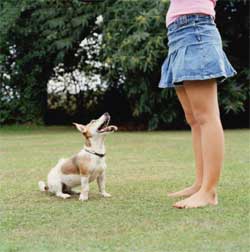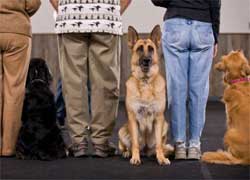Training the sit command to your dog

The basic sit command is one of the essential skills every dog should learn, and easily mastered with which you can build on for more advanced training methods.
It will come in handy for keeping your dog at bay from jumping up on people, and basically a great control command if your dog's getting to be difficult in a situation.
This is probably the first thing to teach your dog, and it's important to get it right. Why?. It sets your dog up for success in understanding performance equals reward and sets the stage for any future training.
The Basics:
- Set your dog up for success by incorporating positive training techniques with patience, praise and practice.
- If training a puppy, start in a quiet area and keep sessions short to maintain the pup's attention.
- Incorporate the 'sit' into your everyday routine by having your dog sit before each meal, or before a walk. This really sends a great message to your dog to be patient, especially before a meal.
- Keep it fun with plenty of variety. Training can be at anytime you and your dog have a couple spare minutes.
- Challenge your dog with longer sit periods which will naturally blend into the stay command.
- If this is your first dog, training a proper sit command will boost both you and your dog's confidence for future obedience training.
Method:
- Get down to a puppy's level by kneeling down on the floor in front of him. This makes you less threatening and your pup will relax while having your attention.
- With treat in hand, slowly move your hand from the dogs nose (for the scent) to above the back of the dogs head while saying "sit" in a clear tone. Your pup has two options, remain standing and backing up or sitting. Dogs are lazy and sitting is easier.
- As soon as the dog's rear end hits the floor, praise by saying "good sit!" and reward him immediately with the treat in hand. This conditioning method is used for positive training as the dog will associate praise and reward with the sit command or any other training commands.
- If the dog jumps up for the treat instead of sitting, you may be holding the treat too far away. Keep your lure hand closer to the dog's nose when moving up towards the top of the dogs head.
- Keep training period's short for puppies, but most catch on to the command very quickly.
What's next?
Once the basic sit command becomes familiar to the dog without the need for the lures, it's time to try a hand signal along with the vocal command.
With your right hand flat, palm facing your dog, bend your elbow and raise your right hand up to waist height. This is the most common, but anything will work as long as you keep it consistent. Personally, I also snap my fingers as I raise my hand.

Stand in front of you dog and combine both the hand and vocal commands. If the dog responds with a sit, reward with a treat and praise immediately.
If your dog doesn't respond, turn away for a couple seconds and try again. If unsuccessful after 3 attempts, return to using the "lure method".
Don't show any disappointment for not sitting, just go back one step and let the dog regain confidence.
After your dog sits reliably with hand and vocal commands, have him sit everywhere. Beside you, behind you, from a distance, even in another room. Practice using only hand or verbal commands at various times to ensure your dog has a firm grasp on the command.
Treats can be eventually phased out, but praise is always a welcome reward in the form of an ear scratch and a reassuring voice.
When on the leash, you may find your dog does not respond to the sit command as easily due to the hundreds of distractions. You may have to ease him into a sit using a simple technique.
Gently lift up and back on the leash to coax him into a sitting position and reward immediately. There is no yanking or jerking on the leash, just a nice even pressure to get his rear on the ground.
Practice makes perfect, and you'll find that your dog is as eager to learn as you are to teach.
Reminder to use sit before meals as it is a powerful reward for performing the command, and challenge your dog with longer and longer sit periods.
The next command of "stay" will be a breeze. Have fun with it!
Reward yourself for a job well done!
Best wishes from dog care basics

Brand new look! Hope you like.
A victory against puppy-mills in Missouri after Prop B vote
Jon Stewart's "The Daily Show" spin on Prop B...hillarious (11/11/10) Clip#2







